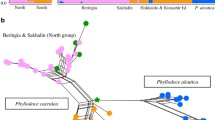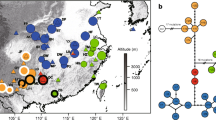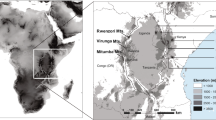Abstract
The species-richness of the flora in the European Alps results from complex interactions between geographical, climatic and environmental factors. In this study, we focus on a complex of closely related Alpine plants: Primula hirsuta, P. pedemontana and their relatives. Using a large DNA dataset of thousands of single-nucleotide polymorphisms sequenced across 149 individuals spanning all the western Alps, we refine phylogenetic relationships in this clade and explore the evolutionary origins of a mysterious lineage found in one valley of the Écrins range (France): the Valgaudemar. In particular, we demonstrate that this lineage did not originate from a simple allopatric divergence, but from an isolated lineage related to Primula pedemontana, which later got introgressed by P. hirsuta. This leads us to develop a phylogeographic scenario explaining the origins of the Valgaudemar lineage, and shed light on a potential glacial refugium in the south of the Écrins range. We believe this study takes part in the deep understanding of the origins of endemism in the European Alps and more generally of the maintaining of species diversity.




Similar content being viewed by others
Data availability
The full DNA alignment (i.e., including invariant sites) used for this study has been added as supplementary material with the submission. It is a DNA alignment in phylip format. Raw data generated for the current study will be made available on a public repository upon acceptance of the manuscript.
References
Altermann S, Leavitt SD, Goward T, Nelsen MP, Lumbsch HT (2014) How do you solve a problem like letharia? A new look at cryptic species in lichen-forming fungi using bayesian clustering and SNPs from multilocus sequence data. PLoS ONE 9(5):e97556. https://doi.org/10.1371/journal.pone.0097556
Arvet-Touvet, C. (1873). Monographie des Pilosella et des Hieracium du Dauphine, suivie de l’analyse de quelques autres Plantes.
Banfi E, Ferlinghetti R (2013) Primula albenensis sp. Nov., una nuova entità del sottogenere Auriculastrum nelle Prealpi Bergamasche (Alpi sudorientali, Lombardia). Webbia. https://doi.org/10.1080/00837792.1993.10670541
Barthlott W, Rafiqpoor D, Kier G, Kreft H (2005) Global Centers of Vascular Plant Diversity. Nova Acta Leopoldina NF, 23.
Blackmon H, Adams RH, Blackmon MH (2013) Package ‘evobiR.’
Boucher FC, Casazza G, Szövényi P, Conti E (2016a) Sequence capture using RAD probes clarifies phylogenetic relationships and species boundaries in Primula sect. Auricula Molecular Phylogenetics and Evolution 104:60–72. https://doi.org/10.1016/j.ympev.2016.08.003
Boucher FC, Zimmermann NE, Conti E (2016b) Allopatric speciation with little niche divergence is common among alpine Primulaceae. J Biogeogr 43(3):591–602. https://doi.org/10.1111/jbi.12652
Boucher FC, Dentant C, Ibanez S, Capblancq T, Boleda M, Boulangeat L, Smyčka J, Roquet C, Lavergne S (2021) Discovery of cryptic plant diversity on the rooftops of the Alps. Sci Rep 11(1):11128. https://doi.org/10.1038/s41598-021-90612-w
Bresinsky A (1965) Zur Kenntnis des circumpolaren Florenelements im Vorland nördlich der Alpen. Berichte Der Bayerischen Botanischen Gesellschaft 38:5–57
Buerkle CA (2005) Maximum-likelihood estimation of a hybrid index based on molecular markers. Mol Ecol Notes 5(3):684–687. https://doi.org/10.1111/j.1471-8286.2005.01011.x
Capblancq T, Després L, Rioux D, Mavárez J (2015) Hybridization promotes speciation in Coenonympha butterflies. Mol Ecol 24(24):6209–6222. https://doi.org/10.1111/mec.13479
Casazza G, Granato L, Minuto L, Conti E (2012) Polyploid evolution and Pleistocene glacial cycles: A case study from the alpine primrose Primula marginata (Primulaceae). BMC Evol Biol 12(1):56. https://doi.org/10.1186/1471-2148-12-56
Casazza G, Grassi F, Zecca G, Mariotti MG, Guerrina M, Minuto L (2013) Phylogeography of Primula allionii (Primulaceae), a narrow endemic of the Maritime Alps: Phylogeography of Primula allionii. Bot J Linn Soc 173(4):637–653. https://doi.org/10.1111/boj.12110
Čertner M, Kolář F, Frajman B, Winkler M, Schönswetter P (2020) Massive introgression weakens boundaries between a regionally endemic allopolyploid and a widespread congener. Perspectives in Plant Ecology, Evolution and Systematics 42:125502. https://doi.org/10.1016/j.ppees.2019.125502
Choler P, Erschbamer B, Tribsch A, Gielly L, Taberlet P (2004) Genetic introgression as a potential to widen a species’ niche: Insights from alpine Carex curvula. Proc Natl Acad Sci 101(1):171–176. https://doi.org/10.1073/pnas.2237235100
Cocker JM, Wright J, Li J, Swarbreck D, Dyer S, Caccamo M, Gilmartin PM (2018) Primula vulgaris (primrose) genome assembly, annotation and gene expression, with comparative genomics on the heterostyly supergene. Sci Rep 8(1):17942. https://doi.org/10.1038/s41598-018-36304-4
Cornuet J-M, Ravignie V, Estoup A (2010) Inference on population history and model checking using DNA sequence and microsatellite data with the software DIYABC (v1.0). BMC Bioinformatics, 11(1): 401. https://doi.org/10.1186/1471-2105-11-401
Cornuet J-M, Pudlo P, Veyssier J, Dehne-Garcia A, Gautier M, Leblois R, Marin J-M, Estoup A (2014) DIYABC v2.0: A software to make approximate Bayesian computation inferences about population history using single nucleotide polymorphism, DNA sequence and microsatellite data. Bioinformatics, 30(8), 1187–1189. https://doi.org/10.1093/bioinformatics/btt763
Crema S, Kadereit JW, Cristofolini G (2013) Phylogenetic Insights into Primula Sect. Auricula in the Apennine Peninsula. Flora Mediterranea, 23. https://doi.org/10.7320/FlMedit23.157
De Queiroz K (2007) Species concepts and species delimitation. Syst Biol 56(6):879–886. https://doi.org/10.1080/10635150701701083
Delunel R (2010) Evolution géomorphologique du massif des Ecrins-Pelvoux depuis le Dernier Maximum Glaciaire. Apports Des Nucléides Cosmogéniques Produits In-Situ. Géomorphologie. Université Joseph-Fourier-Grenoble I (PhD Thesis).
Dhien R (1962) Répartition géographique des Lycopodes français. Publications De La Société Linnéenne De Lyon 31(6):178–181. https://doi.org/10.3406/linly.1962.7059
Ebersbach J, Schnitzler J, Favre A, Muellner-Riehl AN (2017) Evolutionary radiations in the species-rich mountain genus Saxifraga L. BMC Evol Biol 17(1):119. https://doi.org/10.1186/s12862-017-0967-2
Favre A, Päckert M, Pauls SU, Jähnig SC, Uhl D, Michalak I, Muellner-Riehl AN (2015) The role of the uplift of the Qinghai-Tibetan Plateau for the evolution of Tibetan biotas. Biol Rev 90(1):236–253. https://doi.org/10.1111/brv.12107
Feliner GN (2011) Southern European glacial refugia: a tale of tales. Taxon 60(2):365–372. https://doi.org/10.1002/tax.602007
Flantua SG, Hooghiemstra H, Hoorn C (2018) Historical connectivity and mountain biodiversity. Mountains, Climate and Biodiversity, 171–185.
Forest F, Grenyer R, Rouget M, Davies TJ, Cowling RM, Faith DP, Balmford A, Manning JC, Procheş Ş, van der Bank M, Reeves G, Hedderson TAJ, Savolainen V (2007) Preserving the evolutionary potential of floras in biodiversity hotspots. Nature 445(7129):757–760. https://doi.org/10.1038/nature05587
Frichot E, François O (2015) LEA: An R package for landscape and ecological association studies. Methods Ecol Evol 6(8):925–929
Frichot E, Mathieu F, Trouillon T, Bouchard G, François O (2014) Fast and efficient estimation of individual ancestry coefficients. Genetics 196(4):973–983. https://doi.org/10.1534/genetics.113.160572
Fujita MK, Leaché AD, Burbrink FT, McGuire JA, Moritz C (2012) Coalescent-based species delimitation in an integrative taxonomy. Trends Ecol Evol 27(9):480–488. https://doi.org/10.1016/j.tree.2012.04.012
Gaston KJ (2000) Global patterns in biodiversity. Nature 405(6783):220–227. https://doi.org/10.1038/35012228
Gompert Z, Buerkle CA, Buerkle MCA (2010) Package ‘introgress.’ Delta 12:1
Goudet J (2005) Hierfstat, a package for r to compute and test hierarchical F-statistics. Mol Ecol Notes 5(1):184–186. https://doi.org/10.1111/j.1471-8286.2004.00828.x
Hewitt G (2000) The genetic legacy of the Quaternary ice ages. Nature 405(6789):907–913. https://doi.org/10.1038/35016000
Hoang DT, Chernomor O, von Haeseler A, Minh BQ, Vinh LS (2018) UFBoot2: improving the ultrafast bootstrap approximation. Mol Biol Evol 35(2):518–522. https://doi.org/10.1093/molbev/msx281
Hughes CE, Atchison GW (2015) The ubiquity of alpine plant radiations: from the andes to the hengduan mountains. New Phytol 207(2):275–282. https://doi.org/10.1111/nph.13230
Kadereit JW (2017) The role of in situ species diversification for the evolution of high vascular plant species diversity in the European Alps—a review and interpretation of phylogenetic studies of the endemic flora of the Alps. Perspectives in Plant Ecology, Evolution and Systematics 26:28–38. https://doi.org/10.1016/j.ppees.2017.03.002
Kadereit JW, Goldner H, Holstein N, Schorr G, Zhang L-B (2011) The stability of quaternary speciation: a case study in primula sect. Auricula Alpine Botany 121(1):23–35. https://doi.org/10.1007/s00035-010-0084-y
Kalyaanamoorthy S, Minh BQ, Wong TKF, von Haeseler A, Jermiin LS (2017) ModelFinder: fast model selection for accurate phylogenetic estimates. Nat Methods 14(6):587–589. https://doi.org/10.1038/nmeth.4285
Kassambara, A., & Mundt, F. (2017). Package ‘factoextra.’ Extract and Visualize the Results of Multivariate Data Analyses, 76.
Kastally C, Trasoletti M, Mardulyn P (2019) Limited gene exchange between two sister species of leaf beetles within a hybrid zone in the Alps. J Evol Biol 32(12):1406–1417. https://doi.org/10.1111/jeb.13538
Kier G, Mutke J, Dinerstein E, Ricketts TH, Küper W, Kreft H, Barthlott W (2005) Global patterns of plant diversity and floristic knowledge: Global plant diversity. J Biogeogr 32(7):1107–1116. https://doi.org/10.1111/j.1365-2699.2005.01272.x
Körner C, Paulsen J, Spehn EM (2011) A definition of mountains and their bioclimatic belts for global comparisons of biodiversity data. Alp Bot 121(2):73. https://doi.org/10.1007/s00035-011-0094-4
Körner, C. (2003). The alpine life zone. In C. Körner (Ed.), Alpine Plant Life: Functional Plant Ecology of High Mountain Ecosystems (pp. 9–20). Springer. https://doi.org/10.1007/978-3-642-18970-8_2
Kress A (1989) Primulaceen-Studien. 10. Chromosomenzählungen an verschiedenen Primulaceen.-Teil C. Primula, Sectio Auricula. A. Kress.
Kropf M, Comes HP, Kadereit JW (2006) Long-distance dispersal vs vicariance: the origin and genetic diversity of alpine plants in the Spanish Sierra Nevada. New Phytol 172(1):169–184. https://doi.org/10.1111/j.1469-8137.2006.01795.x
Mamantov MA, Gibson-Reinemer DK, Linck EB, Sheldon KS (2021) Climate-driven range shifts of montane species vary with elevation. Glob Ecol Biogeogr 30(4):784–794. https://doi.org/10.1111/geb.13246
Marini L, Prosser F, Klimek S, Marrs RH (2008) Water-energy, land-cover and heterogeneity drivers of the distribution of plant species richness in a mountain region of the European Alps. J Biogeogr 35(10):1826–1839. https://doi.org/10.1111/j.1365-2699.2008.01924.x
Marx HE, Dentant C, Renaud J, Delunel R, Tank DC, Lavergne S (2017) Riders in the sky (islands): Using a mega-phylogenetic approach to understand plant species distribution and coexistence at the altitudinal limits of angiosperm plant life. J Biogeogr 44(11):2618–2630. https://doi.org/10.1111/jbi.13073
McKay BD, Zink RM (2015) Sisyphean evolution in Darwin’s finches. Biol Rev 90(3):689–698. https://doi.org/10.1111/brv.12127
Minder AM, Widmer A (2008) A population genomic analysis of species boundaries: Neutral processes, adaptive divergence and introgression between two hybridizing plant species. Mol Ecol 17(6):1552–1563. https://doi.org/10.1111/j.1365-294X.2008.03709.x
Minder AM, Rothenbuehler C, Widmer A (2007) Genetic structure of hybrid zones between Silene latifolia and Silene dioica (Caryophyllaceae): Evidence for introgressive hybridization. Mol Ecol 16(12):2504–2516. https://doi.org/10.1111/j.1365-294X.2007.03292.x
Minh BQ, Schmidt HA, Chernomor O, Schrempf D, Woodhams MD, von Haeseler A, Lanfear R (2020) IQ-TREE 2: New Models and Efficient Methods for Phylogenetic Inference in the Genomic Era. Mol Biol Evol 37(5):1530–1534. https://doi.org/10.1093/molbev/msaa015
Nguyen L-T, Schmidt HA, von Haeseler A, Minh BQ (2015) IQ-TREE: A Fast and Effective Stochastic Algorithm for Estimating Maximum-Likelihood Phylogenies. Mol Biol Evol 32(1):268–274. https://doi.org/10.1093/molbev/msu300
Nielsen ES, Beger M, Henriques R, von der Heyden S (2020) A comparison of genetic and genomic approaches to represent evolutionary potential in conservation planning. Biol Cons 251:108770. https://doi.org/10.1016/j.biocon.2020.108770
Ottenburghs J (2020) Ghost Introgression: Spooky Gene Flow in the Distant Past. BioEssays 42(6):2000012. https://doi.org/10.1002/bies.202000012
Ozenda P (1995) L’endémisme au niveau de l’ensemble du Système alpin. Acta Botanica Gallica 142(7):753–762. https://doi.org/10.1080/12538078.1995.10515302
Patsiou TS, Conti E, Zimmermann NE, Theodoridis S, Randin CF (2014) Topo-climatic microrefugia explain the persistence of a rare endemic plant in the Alps during the last 21 millennia. Glob Change Biol 20(7):2286–2300. https://doi.org/10.1111/gcb.12515
Pauli, H., & Halloy, S. R. P. (2019, December 23). High Mountain Ecosystems Under Climate Change. Oxford Research Encyclopedia of Climate Science. https://doi.org/10.1093/acrefore/9780190228620.013.764
Peterson BK, Weber JN, Kay EH, Fisher HS, Hoekstra HE (2012) Double digest RADseq: an inexpensive method for de novo SNP discovery and genotyping in model and non-model species. PLoS ONE 7(5):e37135. https://doi.org/10.1371/journal.pone.0037135
Prosser F, Scortegagna S (1998) Primula recubariensis, a new species of Primula sect. Auricula Duby endemic to the SE Prealps, Italy. Willdenowia, 28(1/2), 27–46. https://doi.org/10.3372/wi.28.2802
Rahbek C, Borregaard MK, Colwell RK, Dalsgaard B, Holt BG, Morueta-Holme N, Nogues-Bravo D, Whittaker RJ, Fjeldså J (2019) Humboldt’s enigma: What causes global patterns of mountain biodiversity? Science 365(6458):1108–1113. https://doi.org/10.1126/science.aax0149
Reutimann O, Gugerli F, Rellstab C (2020) A species-discriminatory single-nucleotide polymorphism set reveals maintenance of species integrity in hybridizing European white oaks (Quercus spp.) despite high levels of admixture. Annals of Botany, 125(4), 663–676. https://doi.org/10.1093/aob/mcaa001
Schonswetter P, Stehlik I, Holderegger R, Tribsch A (2005) Molecular evidence for glacial refugia of mountain plants in the European Alps. Mol Ecol 14(11):3547–3555. https://doi.org/10.1111/j.1365-294X.2005.02683.x
Schorr G, Holstein N, Pearman PB, Guisan A, Kadereit JW (2012) Integrating species distribution models (SDMs) and phylogeography for two species of Alpine Primula: Distribution Models and Phylogeography. Ecol Evol 2(6):1260–1277. https://doi.org/10.1002/ece3.100
Šingliarová B, Chrtek J, Mráz P (2008) Loss of genetic diversity in isolated populations of an alpine endemic Pilosella alpicola subsp. ullepitschii: effect of long-term vicariance or long-distance dispersal? Plant Systematics and Evolution, 275(3–4), 181–191. https://doi.org/10.1007/s00606-008-0058-3
Smyčka J, Roquet C, Renaud J, Thuiller W, Zimmermann NE, Lavergne S (2017) Disentangling drivers of plant endemism and diversification in the European Alps—a phylogenetic and spatially explicit approach. Perspectives Plant Ecol Evol Systematics 28:19–27. https://doi.org/10.1016/j.ppees.2017.06.004
Smyčka J, Roquet C, Boleda M, Alberti A, Boyer F, Douzet R, Perrier C, Rome M, Valay J–G, Denoeud F, Šemberová K, Zimmermann NE, Thuiller W, Wincker P, Alsos I, Coissac E, the PhyloAlps consortium, Lavergne S (2022) Tempo and drivers of plant diversification in the European mountain system. Nat Commun 13:2750. https://doi.org/10.1038/s41467-022-30394-5
Spehn EM, Rudmann-Maurer K, Körner C (2011) Mountain biodiversity. Plant Ecolog Divers 4(4):301–302. https://doi.org/10.1080/17550874.2012.698660
Szövényi P, Arroyo K, Guggisberg A, Conti E (2009) Effects of Pleistocene glaciations on the genetic structure of Saxifraga florulenta (Saxifragaceae), a rare endemic of the Maritime Alps. Taxon 58(2):532–543. https://doi.org/10.1002/tax.582017
Taberlet P, Fumagalli L, Wust-Saucy A, Cosson J (1998) Comparative phylogeography and postglacial colonization routes in Europe. Mol Ecol 7(4):453–464. https://doi.org/10.1046/j.1365-294x.1998.00289.x
Testolin R, Attorre F, Borchardt P, Brand RF, Bruelheide H, Chytrý M, De Sanctis M, Dolezal J, Finckh M, Haider S, Hemp A, Jandt U, Kessler M, Korolyuk AY, Lenoir J, Makunina N, Malanson GP, Montesinos-Tubée DB, Noroozi J, Jiménez-Alfaro B (2021) Global patterns and drivers of alpine plant species richness. Glob Ecol Biogeogr 30(6):1218–1231. https://doi.org/10.1111/geb.13297
van der Beek P, Bourbon P (2008) A quantification of the glacial imprint on relief development in the French western Alps. Geomorphology 97(1–2):52–72. https://doi.org/10.1016/j.geomorph.2007.02.038
Weir BS, Cockerham CC (1984) Estimating F -statistics for the analysis of population structure. Evolution 38(6):1358–1370. https://doi.org/10.1111/j.1558-5646.1984.tb05657.x
Zhang L-B, Kadereit JW (2004) Classification of Primula sect. Auricula (Primulaceae) based on two molecular data sets (ITS, AFLPs), morphology and geographical distribution. Botanical J Linnean Soc 146(1): 1–26. https://doi.org/10.1111/j.1095-8339.2004.00301.x
Zhang L, Comes HP, Kadereit JW (2004) The temporal course of quaternary diversification in the european high mountain endemic Primula sect. Auricula (Primulaceae). Int J Plant Sci 165(1): 191–207. https://doi.org/10.1086/380747
Acknowledgements
We thank the Ecrins National Park rangers C. Albert, N. Bertrand, R. Bonet, S. Durix, M. Garnier, T. Maillet, B. Merhan, E. Ollieu, D. Vincent, as well as P. Dufour, M. Jaunatre and S. Lavergne for sampling. We are grateful to the Vanoise National Park for allowing the collection of P. pedemontana on its territory (permit n°2019-800878). P. Salomez gave his expertise and advices. J. Renaud provided precious help with QGIS and for the Primula distribution information. T. Delahaye and L. Garraud gave advice for sampling and S. Lavergne provided insightful comments on a previous version of this manuscript. S. Sherpa and C. Kebaili gave us numerous methodological advices. The reference chloroplast of P. pedemontana was made available to us thanks to the PhyloAlps project. Funding was provided by the Ecrins National Park through the PITEM Biodiv’ALP project (ALCOTRA).
Funding
This study was funded by Ecrins National Park through the PITEM Biodiv’ALP project (ALCOTRA).
Author information
Authors and Affiliations
Contributions
CD & FCB conceived ideas for this study and collected most of the samples. DR & FCB produced the genomic data. FCB did the bioinformatic treatment and CV ran phylogenetic and population genetic analyses. CV wrote the manuscript with contributions from all co-authors.
Corresponding author
Ethics declarations
Conflict of interest
The authors declare no conflict of interest.
Ethical standard
Non applicable here.
Additional information
Publisher's Note
Springer Nature remains neutral with regard to jurisdictional claims in published maps and institutional affiliations.
Supplementary Information
Below is the link to the electronic supplementary material.
Rights and permissions
Springer Nature or its licensor holds exclusive rights to this article under a publishing agreement with the author(s) or other rightsholder(s); author self-archiving of the accepted manuscript version of this article is solely governed by the terms of such publishing agreement and applicable law.
About this article
Cite this article
Voisin, C., Dentant, C., Rioux, D. et al. Introgression of an isolated Primula lineage suggests the existence of a glacial refugium in the Écrins range (Southwestern French Alps). Alp Botany 133, 21–33 (2023). https://doi.org/10.1007/s00035-022-00288-9
Received:
Accepted:
Published:
Issue Date:
DOI: https://doi.org/10.1007/s00035-022-00288-9




